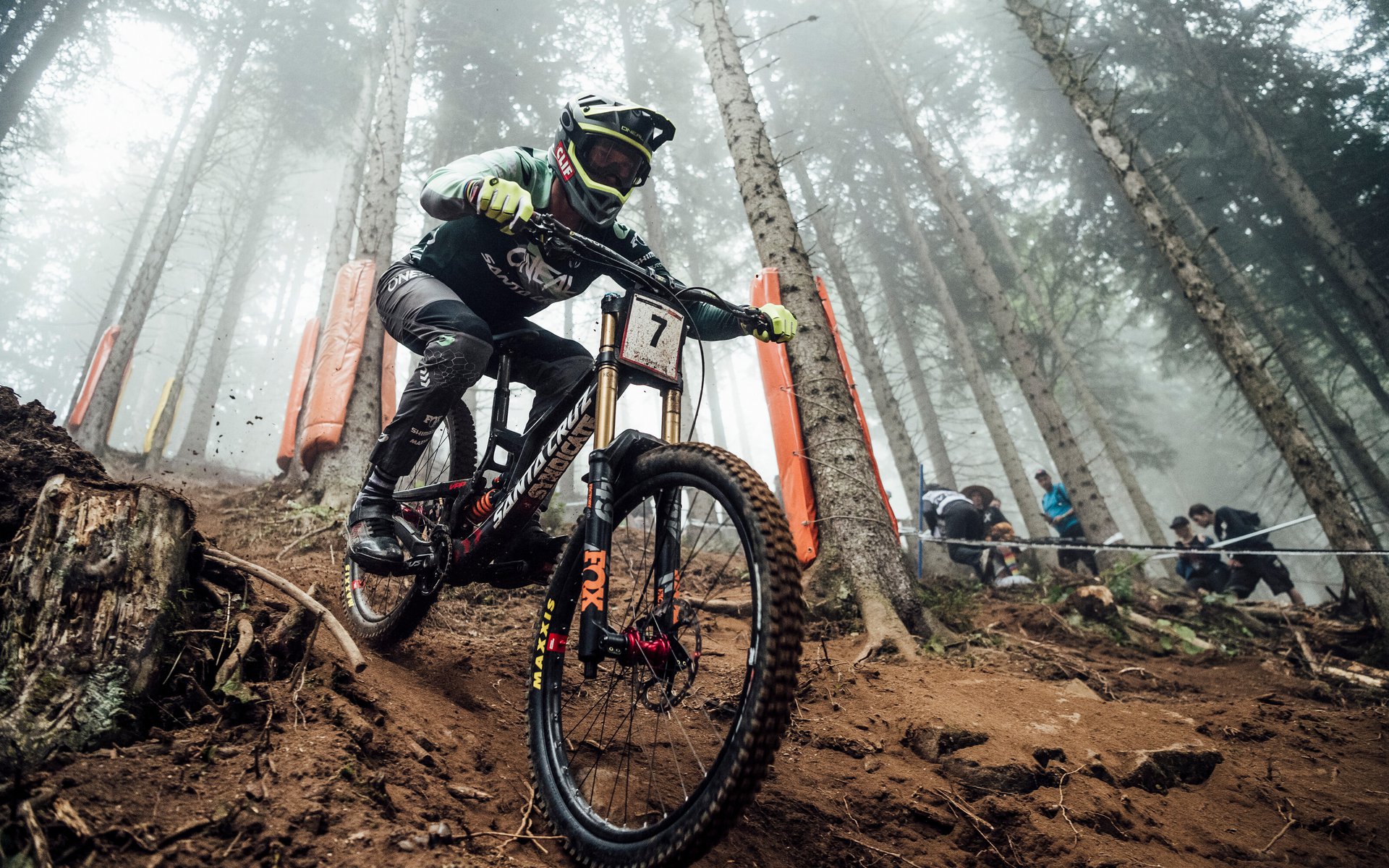
Interview
Greg Minnaar's Hunt For Perfect Geometry
Over his 20 years racing World Cup Downhill, Greg Minnaar has experienced a massive change in downhill bikes. He's raced the Kona Stab Dee-Lux, Orange 222 and was the lead rider for the Honda RN01 project. But for the last 11 years he's been aboard the Santa Cruz V10. In that time he’s helped develop the bike that has become the winningest downhill bike in history. It's fitting considering GM is the winningest racer in history, but not all of the bike's wins were his, nor were all of his wins on the V10. Steve Peat, Josh Bryceland, and Nathan Rennie have all had a hand in the tally – Loris Vergier has one to his name too.
During his 11 years on the V10, bikes have generally grown in length and considering he's 6'3", Greg has always ridden the biggest bikes he can get. When Santa Cruz released the V10 29, Greg commented on how well it fit and since then I've heard him say it's likely more to do with the increased wheelbase than the wheel size alone. Outside of the World Cup it's reviewed well in bike tests and local park rats and weekend racers enjoy it too. But neither the bike or Greg's goals for it are complete and this season he continued making changes. The most obvious to outsiders like me is the experimentation being done with the rear chainstays.
Until recently, the shortest possible chainstays were the rage. And for some, they still are. Whether it’s because they’re being developed using a dartboard decision-making process or the result of actual engineering, short chainstays are going the way of 26" wheels. More brands are beginning to lengthen the rear centre to better position rider mass between the wheels. For downhill bikes being raced at the World Cup level, improving weight distribution and lengthening the wheelbase of the bike allows for increased comfort at higher speeds. This stability is great but it’s long been considered that bikes with long rear centres can't corner well in tight sections or handle slower speeds. I don't believe that to be true, but slower speeds aren’t something Greg Minnaar needs to worry about, and he can probably corner a limo down a tight trail better than most of us on a bmx.
I reached out to Seb Kemp of Santa Cruz Bikes to see if he could connect me with GM so I could pick his brain. I wanted to find out what Greg’s looking for, what he’s discovered, and what his thoughts are on going even longer.
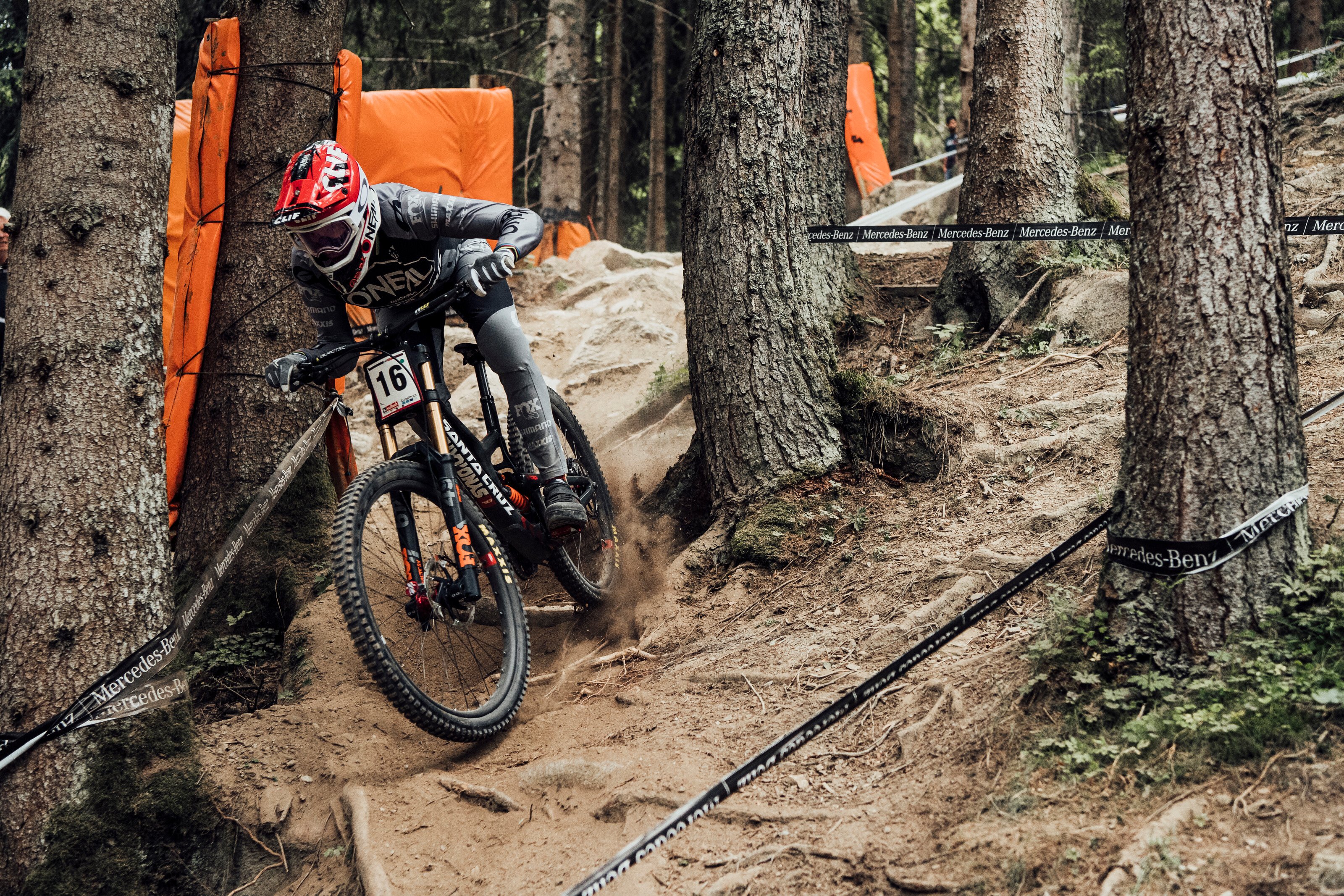
Greg on his stock V10 setup for the Leogang World Cup this year. Photo: Bartek Wolinski/Red Bull
Greg. Congrats on how the season is going so far, it’s good to see you well into the top 10 in the overall. Are you reasonably happy with the way things are going?
Yea, it's not too bad I guess. I must be honest I’m not overly excited about how things have gone. But I guess after such a poor start—not qualifying in Maribor—I’m stoked to be lying 6th overall.
You’ve become quite well known for fettling with your bike and puzzling with suspension settings. Do you think being known for it is warranted? I mean, are there others who are tweaking and adjusting during a race weekend at least as much as you (*cough* Loris Vergier) but perhaps aren't getting the same media attention for it?
Sure, everyone is trying to tune the bike to be as fast and as comfortable as possible, for sure some more than others. For me it's probably been a combination of two things; one, not riding enough DH and the second being the overcompensation and the strain on my bike being so tall. Now that I’m more centred on the bike there's less strain on isolated parts of my bike.
Yourself and the Syndicate get together early in the season to work on some base tunes and setups. How beneficial is that early-season testing?
I find it super important, you need a solid base going into a season. Of course, your bike will firm up going into a World Cup but you don’t want that adjustment being a major leap.

Greg was able to hold onto 6th in the overall after an uncharacteristic first race in Maribor. He was pipped for 5th by teammate, Loris Vergier. Photo: Bartek Wolinski/Red Bull
The reason I want to be more centred is because, regardless of how tight the corner is, I’ll be able to ride it with a lot more confidence being in the middle of the bike, same goes for tech sections, mud etc. There won’t be this pushing and pulling trying to centre myself. – Greg Minnaar
Roughly how far do your suspension settings shift from those test sessions during the season?
They haven’t shifted too much. For example, 4psi in the fork, then 1 or 2 clicks of rebound to cater for the higher volume of air.
You’re a tall fella and your bike has grown quite a bit over the years. Do you feel like it’s got room to grow more or have you found a happy place?
I think we have felt the max reach finally, but I do feel there's a little bit of growth possible on the rear end.
The increases in length have steadily grown with each update (not just with your bikes). Do you ever think about taking a big leap forward—almost purposely too far—and then coming back a bit to get the final fit?
The only problem with growing too big too soon is the foreign feeling is so far from your comfort you can never feel comfortable, whereas baby steps allow you to grow with not much change to your comfort.
In Andorra, you were testing a 17mm longer chainstay/rear-center. What were you chasing with the longer rear on the bike?
We had done quite a lot of testing before Andorra with the 17mm longer rear end. What it allows is for me to be more centred with better weight distribution. I’m going on a lot about being centred. The reason I want to be more centred is because, regardless of how tight the corner is, I’ll be able to ride it with a lot more confidence being in the middle of the bike, same goes for tech sections, mud etc. There won’t be this pushing and pulling trying to centre myself.
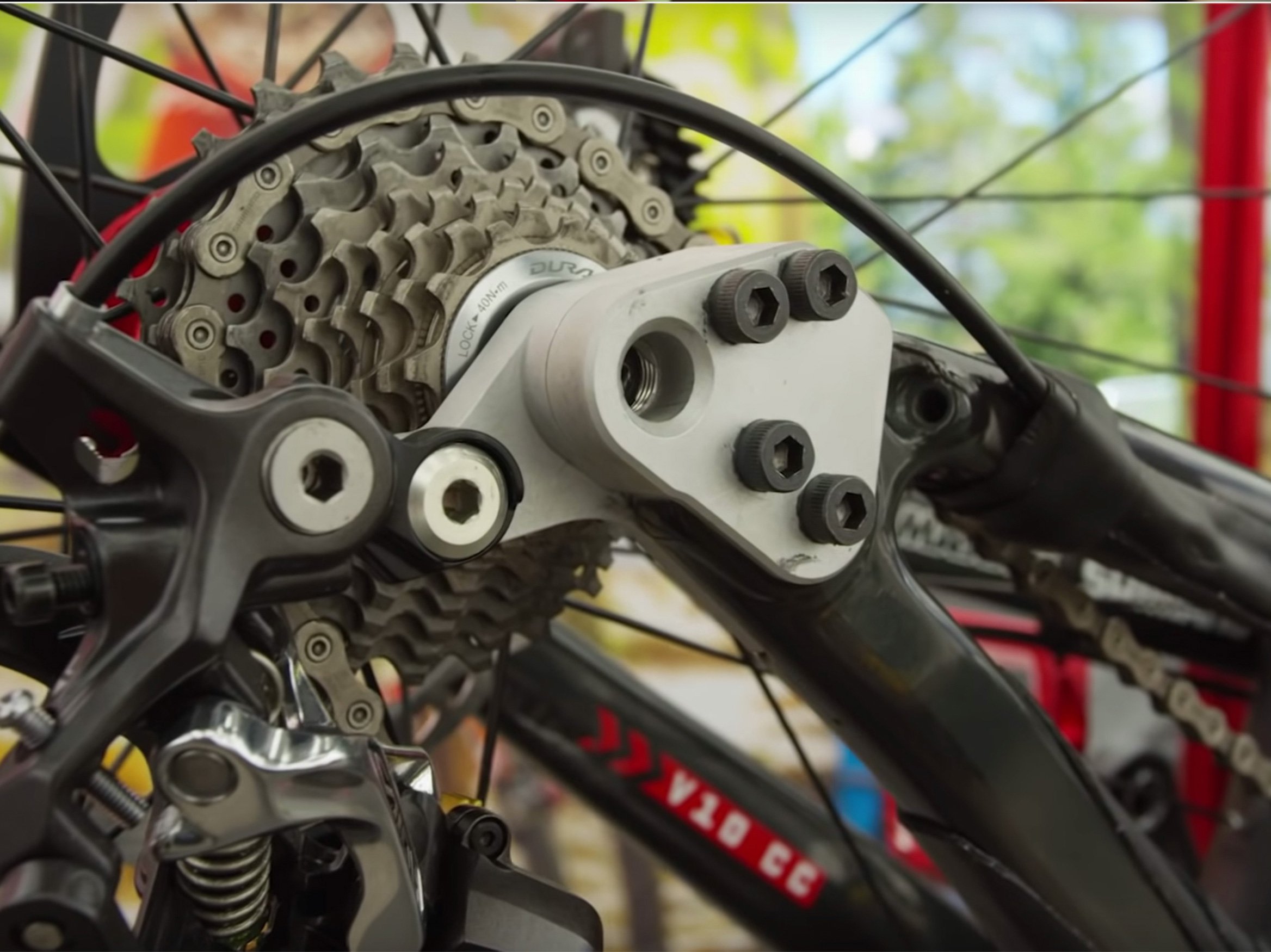
The drive side of Greg's bike with the first rear centre lengthening chip.
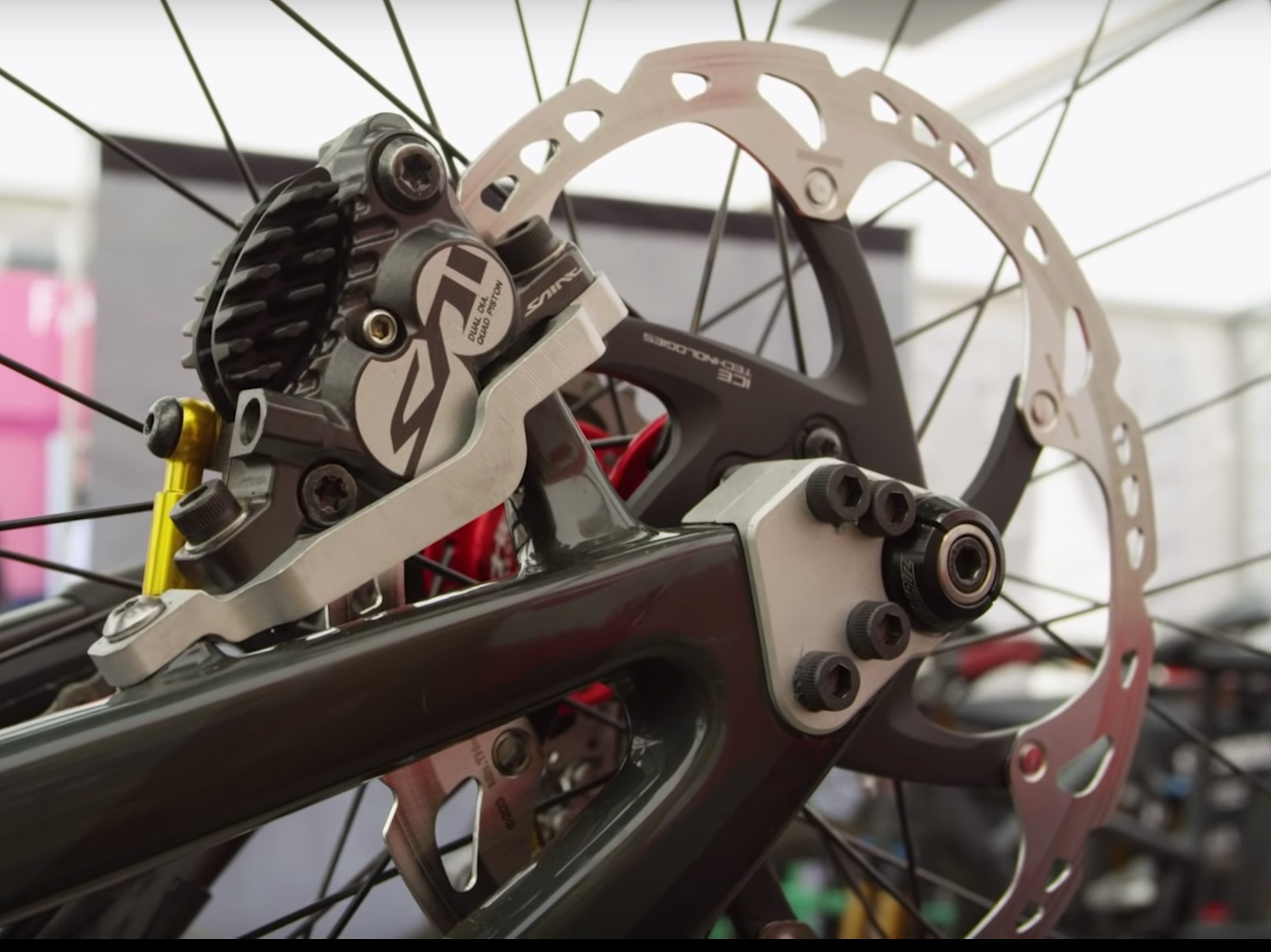
The non-drive side. The chips are 20mm long but a custom link brings things back to 17mm.
How did you arrive at 17mm? Why not 10mm, for example.
It was the simplest way SCB engineers were able to create the extenders, then shortened up using the link… so the shortest and simplest way gave us 17mm, at that time. Nick has now found another way to do it so we can try 5–10mm.
What did you like about the longer chainstay?
More active suspension, stability and the cornering.
What didn’t you like?
[It] made the front end feel really long on the steep sections.
I was surprised to hear that you didn’t try the longer rear end in Les Gets. Is that true?
I was nervous to, as the wood section was pretty steep. I didn’t think I would make up enough time to afford losing time in the woods.
Do you think you’ll do more testing with longer rear centers in the future?
Yes for sure.
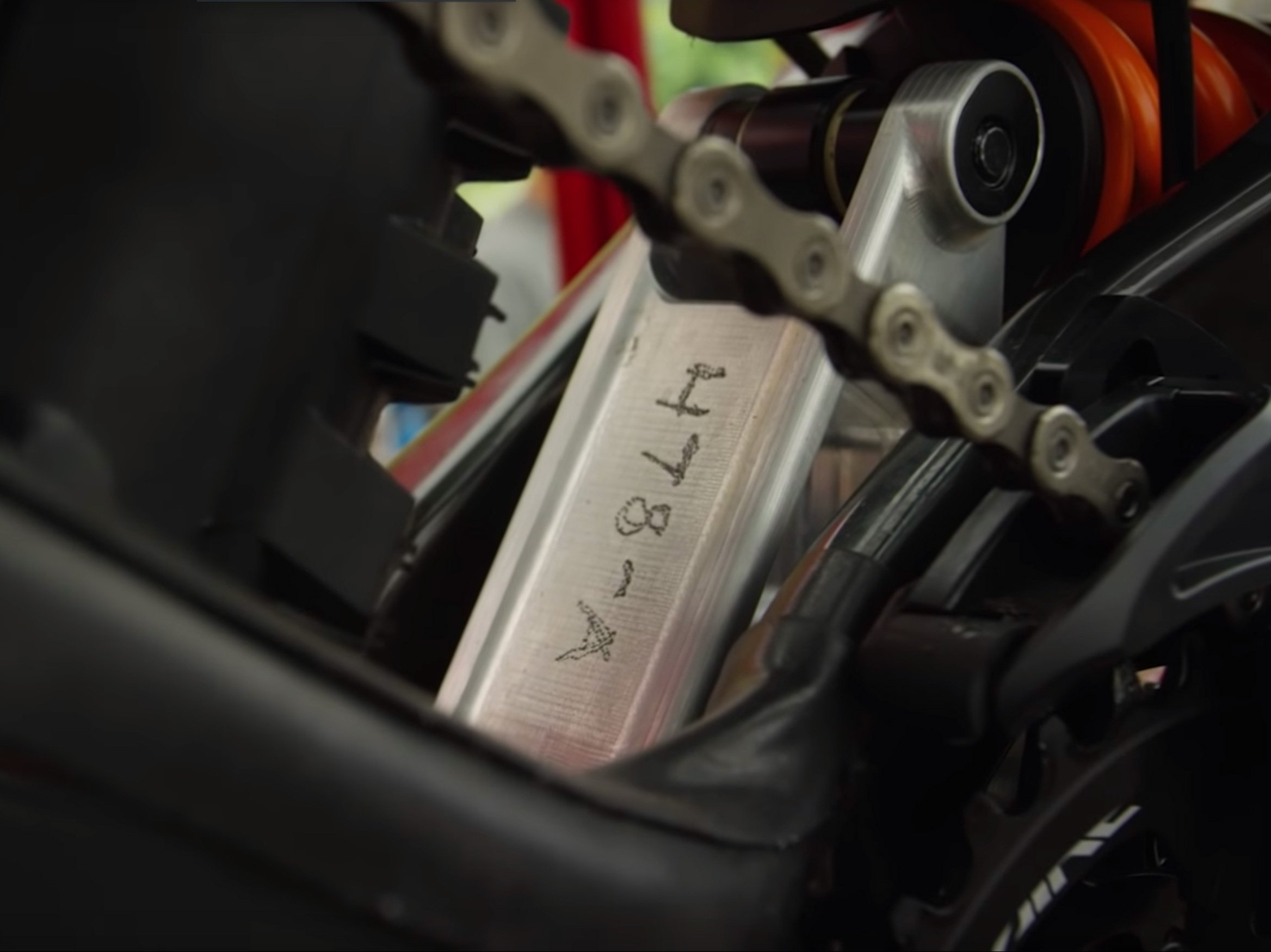
The custom link brings the rear centre back 3mm from the 20mm of the chips while keeping the suspension kinematics as they were.
How do you decide which race you’re going to make a more significant change to your bike like a longer rear-center?
We had a week of testing prior to Andorra, and everything was working out, I felt like the track was steep enough when testing… but clearly not 😂
You're working more on weight distribution through length and proportions of front to rear center. Have you been making any adjustments to BB drop or head angle as well, or are they something you’re pretty happy with at the moment?
We have played about with BB and head angle before but I feel we're in the sweet spot on both now.
Both suspension and geometry are important but if you had to pick one, which would it be?
Suspension, you can do so much with suspension.
What’s next? Do you have plans for geometry updates in the future?
I’m gonna keep going with the longer rear end, I really feel there's something in it.
Do you ride a longer bike than you used to? If so, what do you notice most?







Comments
Alex D
4 years, 6 months ago
As a long-legged person who feels ridiculous perched behind the rear wheel on short-chainstay bikes, I'm all for a pendulum swing in the other direction.
Reply
robnow
4 years, 6 months ago
Since you have the Seb Kemp on speed dial, can you ask him why the Santa Cruz marketers decided both the Megatower and Tallboy deserve the adjustable chainstay chip yet probably their most popular (and reasonable to have it) bike the Hightower did not get the same treatment?
Reply
Seb_Kemp
4 years, 6 months ago
Hi robnow,
I decided to sign up to comments just to save AJ being the middle man. And I'll be the middleman for the engineers because at Santa Cruz us chin-flapping marketers don't get to go anywhere near the design stage of any products. Sometimes I think it would be nice if we could...but then I start thinking about time-traveling unicorns so I just get back to thinking about what font size would look rad in the next dealer catalog.
Anyway, to the answers...
The Megatower is intended for the most aggressive and progressive of riders and likely for those with racing or fettling desires. Having the option to tune the rear centre measurement is great for this kind of application and rider type, whether because of height or setup preference. From Finale Ligure rock blasting to Tweed Valley turns, or stubby little pinner to viking-esque brawler, choose your own setup.
The Tallboy's chainstays are super short (in short position it's 430mm which is, in @bicyclepubes vernacular, "tuct!") so the bike is agile and lively (it's a 120/130mm bike so it wants to dip, duck, dive on local trails). But for XL and XXL riders who might want more balance the rear axle flip chip allows them to even things out by going to long position (+10mm, so 440mm). It's also useful for those riders that want a super stable climbing position and more stability for high speed mobbing, regardless of their height.
There's one other reason, but it's not a big reason. Switching to the Long setting also allows space for 29 x 2.6 tires. Early in the development of the Tallboy (4) there was speculation that 29x2.6 might take off and that compatibility would be a ‘must have’ on a bike like this—this scenario appears to not have materialized though some riders seem to like the idea (East Coast rock crawlers, for example). Personally I think this bike rides better with narrower, faster tires, not big mushy balloons. It's a power-hour or all-the-hours Microtower.
So onto the Hightower. This is more of an all-round trail bike so the chainstays are a nice 433mm which sits between the Megatower (435mm - in short) and Tallboy (430mm - in short). This is a simply honest chainstay measurement for most types of riders, in most places, without adding in the head scratching of a lot of extra adjustments. You know, the "But should I be messing around with all these options? Could it be better if I change this? Will it be worse? What am I feeling? Argh!!! I just want to ride my damn bike!"
Of note, however, is that we (by 'we' I mean the engineers...who do all the smart people work at Santa Cruz) did make the XXL Hightower's chainstay measurement 439mm so it's more balanced for big, tall riders.
Anyway, I'm back off to lurk in the shadows to make the company Christmas cards. Hopefully this year they let me near the scissors and glitter glue. I think I learned my lesson. Design is fun, and it tastes great.
Seb Kemp
Reply
robnow
4 years, 6 months ago
Thanks Seb,
As an XL rider I have ridden the Megatower in the Long position and preferred the balance both down and up (more traction, less wheelie). I would've liked to have seen the Hightower2 get the same treatment...and probably would've got one.
Reply
robnow
4 years, 6 months ago
This comment has been removed.
Vik Banerjee
4 years, 6 months ago
Companies making different length rear triangles is interesting. I kind of hope they start offering customers the opportunity to mix and match front and rear triangles since as you note what is the "best" CS length [or ratio to FC] is not a settled issue. It would be great to be able to order up you CS length and FC to meet your needs. Even if there was an up charge for the service to cover the extra costs or if it was offered as a frame only option to avoid the hassles of adjusting complete bikes.
Companies that are offering adjustable CS are slicing the problem another way since they can cover the desired CS length range with fewer rear triangles. It's also nice as a customer to be able to change CS length as you may want your bike shorter on slow techy days and longer on high speed days. Adjustable CS combined with adjustable FC [ie Guerrilla Gravity] gives the customer a lot of ways to tweak their bikes.
The other obvious option is made to order bikes like what the Athertons are offering. Where a customer can just dial in their preferred CS/FC STA/HTA...at least within a certain range. As 3-D printing for consumer goods becomes more common the prices for these items can drop making custom or semi-custom bikes affordable for a wider audience.
Reply
Jerry Willows
4 years, 6 months ago
How do you know what works for you without lots of testing like GM ?
Reply
Endur-Bro
4 years, 6 months ago
The last thing is Joeys need is the option to F up our bikes even more.
I considered custom Geo for my G16 or longer RC but I’m a shut flinging monkey so best if I colour between the lines on this one.
Reply
Timer
4 years, 6 months ago
TBH, i don't think there are many people actually knowledgeable enough to make use of made-to-order geo. Being a self proclaimed expert on geo and talking about preferred numbers is very fashionable right now, but few know about the complex interactions of all those numbers. And that is not even taking into account the compromises that have to be made for tire-clearance, shock location, bearing placement, strength-to-weight and how all those numbers react in dynamic ride situations.
Greg Minnaar is one of those who might jot down some numbers and the resulting bike will feel great for him, but for most people such an attempt will probably end badly.
Reply
Vik Banerjee
4 years, 6 months ago
You have to choose your poison. Either you accept a generic geo that's not made for you, but some "average" rider with whom you only share some traits with or you make your own choices and assume the risk you don't make good ones.
Splitting the difference are designs that have some adjustability [CS length, FC length, shock bolt placement, HTA/STA] so the bike designer can put the bike in a zone she feels comfortable will work for the "average" rider and specific customers can adjust aspects of the geo to suit them with no risk since they can just go back to the "average" stock settings.
People have been building custom bikes successfully for many years so it's not like the Atherton approach is totally novel. Part of the custom build process is the customer requesting specific design/performance elements and the builder considering the requests and providing feedback for areas that they think merit concern or further consideration.
We face the same issues with suspension. You either deal with a generic tune which you adjust to the best of your ability or you get your suspension reworked so it's setup specifically for your needs.
Reply
Mammal
4 years, 6 months ago
You're both correct. I think the reasons Timer puts forth, are reasons why the demand for these adjustments doesn't justify the cost or difficulty to most manufacturers. Some of these adjustments are available on a select few bikes, but there are many reasons why not many companies offer them. I recall how many moderate-to-poor reviews came out about Rocky's ride9 adjustments, just because many people didn't understand which position they were most likely to enjoy for their style/terrain. If an adjustment that's made for 10% of purchasers is negatively affecting 40% of short-term reviews, a company is probably going to shy away from providing that.
Reply
AndrewR
4 years, 6 months ago
Ride 9 is a perfect example. Is a rider going to do 3-5 repetitions of the same trail/s in each ride position setting (so 27-45 repetitions), whilst maintaining all other bike settings, and record tangible metrics like power output, effort (heart rate) and time, as well as perceived metrics like comfort, confidence and fun. Record all that in a log book and then crunch the numbers on which setting or settings are best for their riding style/ conditions/ trail type. I think not. Most people don't even have the self discipline to run three repetitions to check a range of tyre pressures let alone the repetitions required to properly set up suspension.
If you do have the self discipline to do all of the above and feel that a geometry change might benefit you (in short most brands do not adjust their rear centre/ chain stay length for frame size increase) then test ride a Norco (they do adjust the effective chain stay for each size) and see if it helps you feel more centred than your current brand. This applies mainly to riders on large or extra large frames as anyone on a medium generally falls within the range of "the average rider for this bike type" considered by the brand at the design and testing stage.
Greg is obviously a candidate for L or XL and is also riding in the 0.05% margin so far above the average rider that every little bit makes a difference.
Feeling naturally centred on a bike is probably the biggest 'game changer' to one's riding.
Reply
Primož Resman
4 years, 6 months ago
Greg is an XXL guy at 196 cm if i'm not mistaken. L is well under 190 cm if you have an XXL bike in your lineup.
As for Norco's chainstays, they move the BB forwards and kill pedalling performance that way since they slacken out the seat tube angle for the riders that need it the steepest. At least that's how they used to do it, i hope they have changed their ways for the better.
fartymarty
4 years, 3 months ago
@AndrewR - your first paragraph nails it.
I think I have a reasonable handle on geometry but would struggle to have the time or consistency to hit this many runs. Adjustable CSs are a great idea but maybe 2 or 3 max settings would do it.
Heathen
4 years, 6 months ago
As Norco changes their CS length with every size I wish Norco would offer different lengths as aftermarket. So people could play around and see what works for them
Reply
robnow
4 years, 6 months ago
Somebody can correct me if I'm wrong but the length of the chainstays on the Norcos don't actually change. Its the pivot behind the bottom bracket that gets moved further back or forward depending on the frame size and this is what lengthens/shortens the Rear Centre...so its a change of the front triangle that alters the Rear Centre length, not a chainstay swap. Unfortunately for Norco they keep the Seattube/Angle relative to the BB so as the frames grow the SA slackens.
Forbidden Druids I believe do the same thing, however they steepen the Seattube/Angle as the frames get bigger to grow the Rear Centre.
Reply
Heathen
4 years, 6 months ago
I was under the impression it was the seat stay that changed. I would love to know what they actually change.
Reply
Velocipedestrian
4 years, 6 months ago
I have two sets of dropouts for my Spitfire, one 10mm longer than the other.
I've had only the obvious revelation - that the shorter set corner quicker, get the front up easier and are more 'fun', while the longer drops are more stable at speed...
No contest for me - I'll take fun over speed any day, but I like that there are options.
(yes, I've tried all the HA options too, and found myself using the same one as everyone else, low.)
Reply
Please log in to leave a comment.